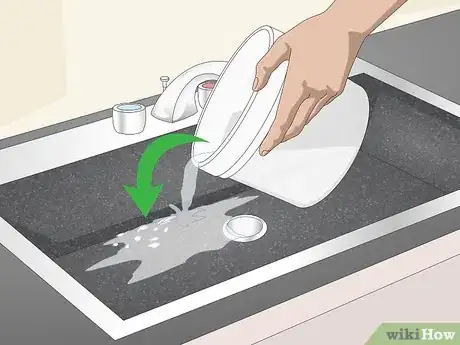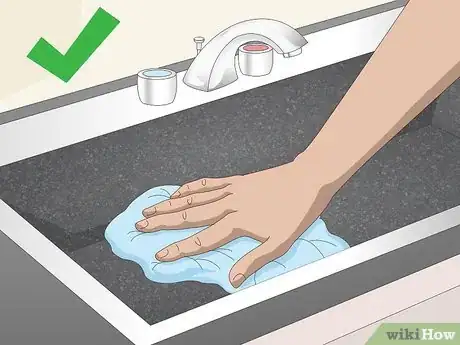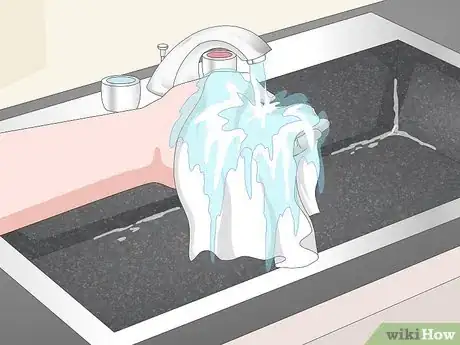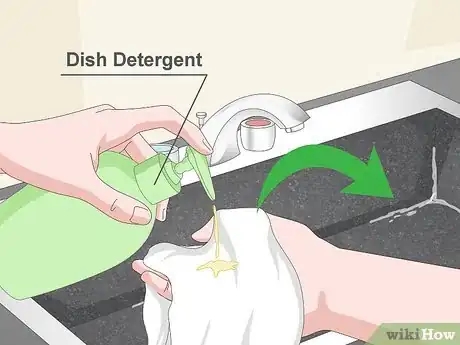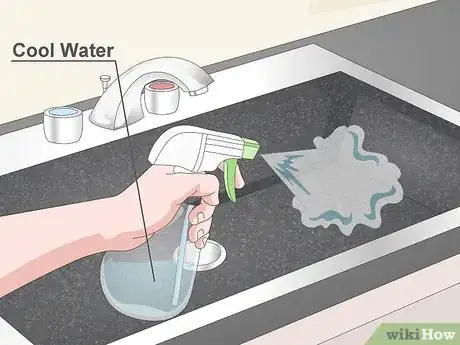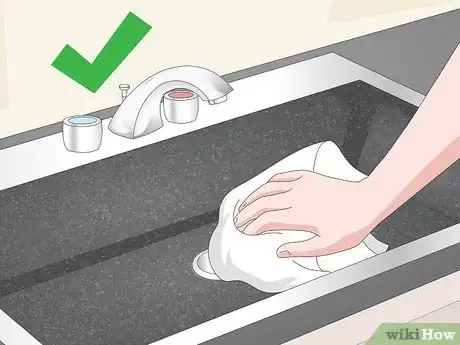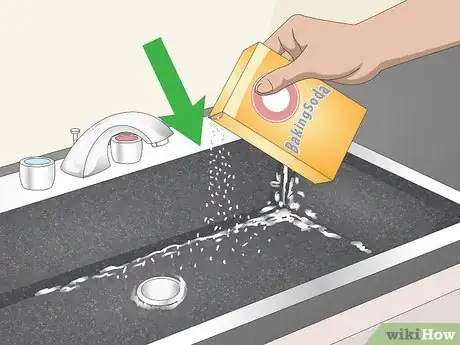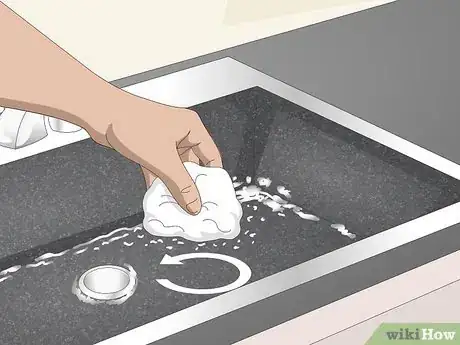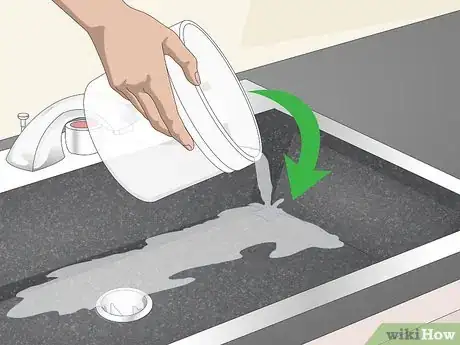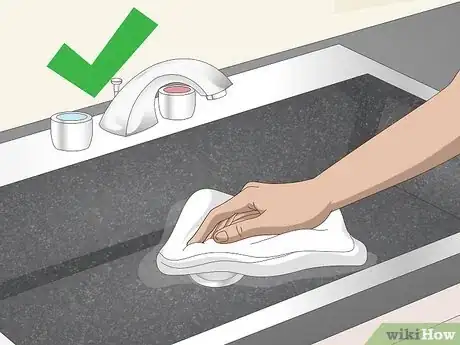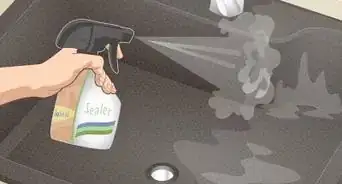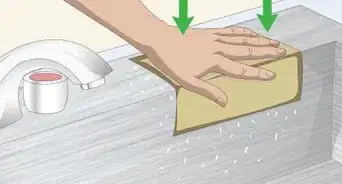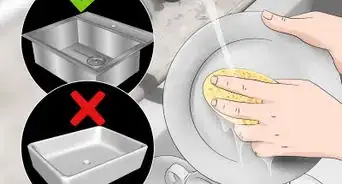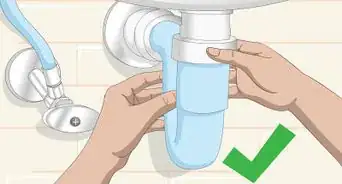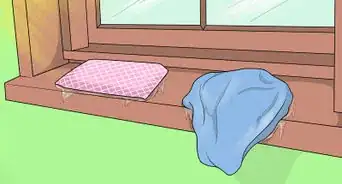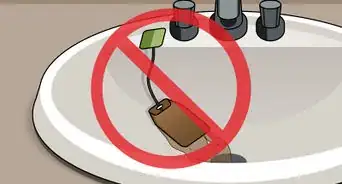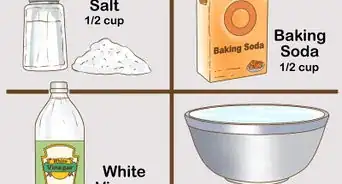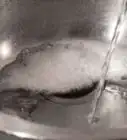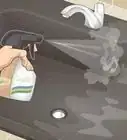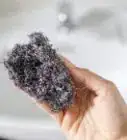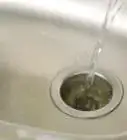This article was co-authored by Alicia Sokolowski. Alicia Sokolowski is a Green Cleaning Specialist and the President and co-CEO of AspenClean, a green cleaning company in Vancouver, British Columbia. With over 17 years of experience, Alicia specializes in creating a healthier, green alternative to chemical-based cleaning products and services. AspenClean develops and manufactures its own line of 100% Natural, EcoCert® certified, and EWG verified™ cleaning products. AspenClean’s glass cleaner was voted Parent’s Green Pick 2020 by readers of the Parents’ magazine. Alicia holds a CPA designation and a Bachelor’s degree in Commerce and Finance from the University of Toronto.
This article has been viewed 108,631 times.
Black sinks usually add a touch of timeless elegance to your kitchen or bathroom. As a bonus, they're made of a mixture of granite, quartz, slate and other natural materials that keep them scratch-resistant. However, those same materials can make black sinks more prone to white stains like soap buildup and limescale (calcium deposits). The good news is that daily simple cleanings will help to reduce the amount of work you'll have to do if you have to combat soap buildup and limescale.
Steps
Performing Daily Cleanings
-
1Use a vinegar solution. Mix equal parts water and distilled white vinegar in a spray bottle. Spray the solution on soap scum and/or food particles. Use a clean soft cloth to scrub the stain. Move in gentle circular strokes. If you notice a grain in the sink, move with it to avoid damaging the surface.[1]
- For an even stronger cleaner, use a mixture of bathroom cleaner, baking soda, and a couple of tablespoons of white vinegar.[2]
-
2Rinse out the sink.[3] Cool or lukewarm water will usually do the trick. Target any remaining debris with the sprayer or your hands. Continue rinsing until all debris has been washed down the drain.[4]Advertisement
-
3
Removing Soap Buildup
-
1Get a clean cloth or towel. Make sure it has a soft texture to avoid damaging your sink. Wet the cloth with lukewarm tap water. Wring out any excess water.[7]
-
2Use dish detergent. Squirt a drop or two of mild dish washing liquid onto the cloth. Scrub in gentle circular strokes until the buildup begins to disappear. Move with the grain of the sink.[8]
-
3Rinse the sink. Use cool water to dilute to dish detergent completely. If you don't have a sprayer, direct the water with your hands or a cup. Target detergent suds and any remaining soap buildup. Continue to rinse until all debris has been flushed down the drain.[9]
-
4Dry the sink. Use a fresh towel or cloth with a soft texture. Move in a gentle circular motion with the grain. Continue until the sink is completely dry.[10]
Removing Limescale
-
1Sprinkle baking soda over the stain. Use enough to lightly cover the stains. How much or how little you use depends on the extent of the staining. You don't have to do any measuring. Let the baking soda sit for up to 30 seconds.[11]
-
2Scrub the stain. Use a clean soft cloth. Move in circular gentle strokes until you feel the limescale begin to loosen. Keep your strokes with the grain of the surface.[12]
- Alternatively, you could make a paste by adding a few drops of water to the baking soda. Use the same gentle circular motions to loosen the limescale.[13]
-
3Rinse the sink. Run lukewarm water over the surface. If you have a sprayer, use it to rinse the sink. Otherwise, direct the stream of water over the surface with your hands or a cup. Keep rinsing until all traces of baking soda and limescale are gone.[14]
-
4Dry the sink. Use a clean cloth or towel with a soft texture. Move in gentle circular strokes with the grain. Continue until the surface of the sink is completely dry. If you leave any water deposits, the lime or calcium in your water will contribute to new buildup.[15]
Expert Q&A
Did you know you can get expert answers for this article?
Unlock expert answers by supporting wikiHow
-
QuestionHow can I make my black sink shine?
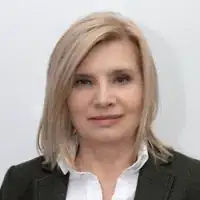 Alicia SokolowskiAlicia Sokolowski is a Green Cleaning Specialist and the President and co-CEO of AspenClean, a green cleaning company in Vancouver, British Columbia. With over 17 years of experience, Alicia specializes in creating a healthier, green alternative to chemical-based cleaning products and services. AspenClean develops and manufactures its own line of 100% Natural, EcoCert® certified, and EWG verified™ cleaning products. AspenClean’s glass cleaner was voted Parent’s Green Pick 2020 by readers of the Parents’ magazine. Alicia holds a CPA designation and a Bachelor’s degree in Commerce and Finance from the University of Toronto.
Alicia SokolowskiAlicia Sokolowski is a Green Cleaning Specialist and the President and co-CEO of AspenClean, a green cleaning company in Vancouver, British Columbia. With over 17 years of experience, Alicia specializes in creating a healthier, green alternative to chemical-based cleaning products and services. AspenClean develops and manufactures its own line of 100% Natural, EcoCert® certified, and EWG verified™ cleaning products. AspenClean’s glass cleaner was voted Parent’s Green Pick 2020 by readers of the Parents’ magazine. Alicia holds a CPA designation and a Bachelor’s degree in Commerce and Finance from the University of Toronto.
Green Cleaning Specialist
-
QuestionCan I use bicarbonate of soda and white wine vinegar?
 Community AnswerUse either baking soda or vinegar (I would use plain old white vinegar). If you put the two together they neutralize each other.
Community AnswerUse either baking soda or vinegar (I would use plain old white vinegar). If you put the two together they neutralize each other.
Things You'll Need
- Soft cloths or towels
- White distilled vinegar
- Dish detergent
- Baking soda
Warnings
- Scratch-resistant isn't scratch-proof! Avoid any scrub sponges, steel wool pads, or anything else that could damage your sink.[17]⧼thumbs_response⧽
- Never use bleach, ammonia, dyes, scouring powders, drain cleaners, or oven cleaners on your sink. They can also damage the composite surface.[18]⧼thumbs_response⧽
References
- ↑ https://www.hunker.com/12262323/how-to-clean-a-black-composite-kitchen-sink
- ↑ Alicia Sokolowski. Green Cleaning Specialist. Expert Interview. 15 September 2020.
- ↑ Alicia Sokolowski. Green Cleaning Specialist. Expert Interview. 15 September 2020.
- ↑ https://www.hunker.com/12262323/how-to-clean-a-black-composite-kitchen-sink
- ↑ Alicia Sokolowski. Green Cleaning Specialist. Expert Interview. 15 September 2020.
- ↑ https://www.hunker.com/12262323/how-to-clean-a-black-composite-kitchen-sink
- ↑ https://www.hunker.com/12262323/how-to-clean-a-black-composite-kitchen-sink
- ↑ https://www.hunker.com/12262323/how-to-clean-a-black-composite-kitchen-sink
- ↑ https://www.hunker.com/12262323/how-to-clean-a-black-composite-kitchen-sink
- ↑ https://www.hunker.com/12262323/how-to-clean-a-black-composite-kitchen-sink
- ↑ https://www.youtube.com/watch?v=_eRQI3tfwuY
- ↑ https://www.youtube.com/watch?v=_eRQI3tfwuY
- ↑ https://www.hunker.com/12262323/how-to-clean-a-black-composite-kitchen-sink
- ↑ https://www.hunker.com/12262323/how-to-clean-a-black-composite-kitchen-sink
- ↑ https://www.youtube.com/watch?v=_eRQI3tfwuY
- ↑ http://www.abodedesigns.co.uk/support/product-care/composite-sinks
- ↑ http://www.abodedesigns.co.uk/support/product-care/composite-sinks
- ↑ http://www.abodedesigns.co.uk/support/product-care/composite-sinks
About This Article
To clean a black sink, start by mixing equal parts water and distilled white vinegar in a spray bottle, and spraying the solution on any soap scum and food particles. For built-up soap scum, try scrubbing your sink with a mild dish washing liquid instead of a water-vinegar solution. Next, use a soft, clean cloth to wipe the sink using circular strokes. Then, rinse the sink to remove the solution and wash any debris down the drain. Finally, dry the sink thoroughly with a soft cloth to avoid damaging the surface. To learn how to remove limescale from your black sink, scroll down!


